“Sadly, our climate and energy policy remains in the grip of an intelligentsia that lacks the wisdom to recognise the boundaries of its own ignorance”. Nick Cater
“…destroying the landscape with inferior technologies that cost more and do not achieve the desired policy aim of Net Zero is insane”. Michael de Percy
I am not sure many people are fully aware of the massive engineering changes currently underway in our rural landscape. The changes are on a scale never attempted in this country before, and it is swallowing obscene amounts of money for minimal benefit and, indeed, no proof it will improve the climate.
If you only listen to Prime Minister Anthony Albanese, the Minister for Climate Change and Energy Chris Bowen, or even the mainstream media, then you would be excused into thinking that the renewable energy transition is achievable, cheap, seamless, wholly affordable and essential for our contribution to prevent a “climate catastrophe”.
As Nick Cater writes:
“They have invested a primitive faith in power from wind, water and sun that defies logical argument. They have convinced themselves that renewable resources are free and inexhaustible, ignoring the tendency of wind and solar to gobble land and capital”.
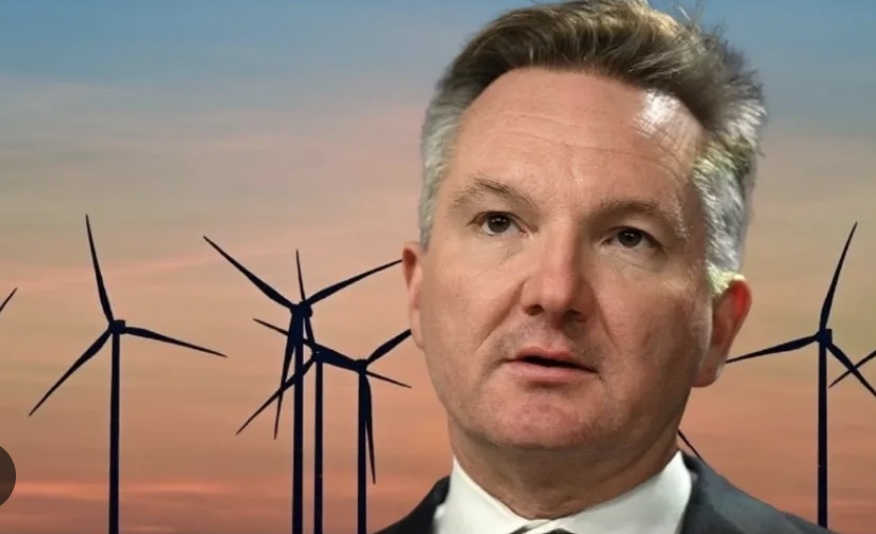
However, the notion that weather-dependent wind and sunshine-dependent solar (with or without pumped hydro or mythical mega-batteries) will soon provide all our power needs is nothing short of delusional. Our Prime Minister contends that the cost of the obvious alternative – nuclear power, which can be available 24 x 365, whatever the weather – is exorbitant, whereas chaotically delivered wind and solar are as cheap as chips. But he ignores that for every megawatt (MW) of wind or solar capacity, another MW of dispatchable generation from coal, gas, diesel, or hydro must be dialled up when the sun sets and/or calm weather prevails.
Many governments in the Western world have committed to achieving net zero carbon emissions in the foreseeable future. The US, Germany and the UK both say they will deliver by 2050, and they believe that wind and solar power can achieve this through heavily subsidised renewable energy projects. There is one problem: these plans have a single, fatal flaw – they rely on the pipedream that there is some affordable way to store surplus electricity at scale. When it comes to battery storage to back up a full wind and solar system without fossil fuels, the problems are massive, and the cost is all out of proportion to the benefits returned. And yet this major issue is ignored when acolytes tell us all we must do is add larger and more batteries.
In Australia, we are not immune to this madness, and the elites from both major parties, their supporters and bureaucrats, have chosen to do it by full electrification.
The mad scramble to a renewable transition
Many city people don’t know what the implications to the environment are in our remote area. It all feels good to them, and they think it’s saving the planet, but they don’t realise how bad it is”.
In October 2021, then Prime Minister Scott Morrison announced a commitment to deliver net zero emissions by 2050, relying on technological breakthroughs to reduce emissions. He was silent on renewable energy plans other than committing a $20 billion investment in low emissions technology.
When Labor formed government after the 2022 federal election, many claimed they had the mandate to introduce their climate and energy policies, notwithstanding they only received 32.8 per cent of the primary votes, the lowest ever for a forming government in Australia. Regardless, Bowen announced the plan to cut CO2 emissions to 43 per cent by 2030 and achieve 82 per cent Net Zero by 2050, at an estimated cost of $78 billion.
This was based on a “roadmap” provided to the government a month after the election by the Australian Energy Market Operator (AEMO), which outlined the path to achieve clean energy targets by 2030. The plan called for the closure of 60 per cent of coal generation capacity by the end of the decade and a massive investment in renewable energy and transmission lines.
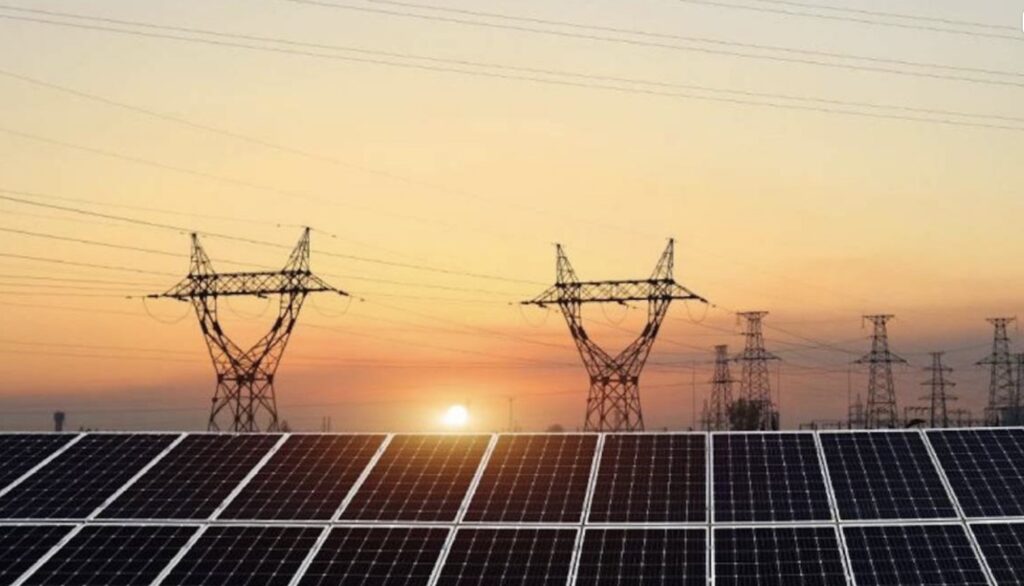
Bowen claimed Labor’s fast-track transition would deliver reliable, secure and affordable power. However, nowhere in their plans did they mention this new renewable energy source will provide baseload power, which is a requirement for industry to meet its intense energy requirement every day of the year. As coal-powered stations close, 23 gigawatts (GW) of relatable baseload power will disappear and will need to be replaced with 75 GW of renewables. On top of that, by 2050, a further 46 GW of dispatchable storage, in all its forms, will be needed to manage daily and seasonal variations in renewable energy output, a difficult task since unsynchronous renewable energy cannot do that.
To put that into context, the equivalent amount of renewable energy to reach that storage amount will require 176 GW of solar output or 138 GW of wind power because the capacity factor for solar is 25 per cent (and that is being generous), and wind is about 30 per cent. The current nameplate in Australia for solar is only 3.2 GW, and wind is 10.2 GW. This means the footprint of land to achieve the needed energy output is monumentally scary.
Bowen admitted his record rate of energy transformation needs to be maintained every year until 2030 to triple the current renewable energy capacity. Then, the country will need almost double the amount again in the following two decades by 2050. This would require the installation of twenty-two thousand 500 W solar panels each day and at least one new 7 MW wind turbine every day until 2030. To ensure the solar and wind factories (they are not farms) provide energy to the eastern grid, at least 10,000 kilometres (now confirmed as high as 28,000 kilometres if the Marinus Project falls over) of new high-voltage transmission lines from the base of Cape York down the east coast into western Victoria and South Australia would need to be built.
The reason for the duplication is the need to turn our electricity flow into a two-way system that can handle the feed-in capacity of millions of individual consumer-owned solar PV systems that the government relies on. Also, many of the wind and solar factories are isolated from the current transmission lines, meaning a lot of kilometres of new lines are needed.
However, Bowen has shown that he cares nothing for the truth and reality in making these promises and commitments. The plan to reach Net Zero and rely on a renewable plus storage model to supply electricity has never been achieved before by any country, and even the International Energy Agency admits it cannot be done with current technology. The economic and security risks are slowly becoming apparent as the national economy suffers and personal liberties are threatened. The costs, risks and feasibility of continuing down the current decarbonisation path are unknown, and Labor has no credible backup plan if we run out of energy.
The reality that Bowen either ignores or just doesn’t know is that electricity for lighting, heating, cooling, ventilation, appliances and electronics accounts for just 20 per cent of total global energy demand. The other 80 per cent are hydrocarbons burned for mining, drilling, industry, manufacturing and transport, passenger and freight. It is a major stumbling block for a Minister who thinks we can electrify everything. He has no idea how the four pillars of modern civilisation – cement, steel, plastic and ammonia – will be produced with renewable energy. Making those four products without fossil fuels is impossible in the foreseeable future. Nor does he have any idea how flying, shipping and trucking – the beating hearts of a global economy – can be powered without burning enormous amounts of carbon. If it is as easy as Bowen claims, why haven’t entrepreneurs fallen over themselves to develop the new technology without needing tax-payer-funded incentives?
The answer is that left to the market, profit motives ensure available and affordable technologies are used, not the pipe dreams we are being fed. All governments do when they dictate the preferred technology is establish a costly false market driven by subsidies that encourage entrepreneurs to skim the money thrown at them without producing a desirable outcome or anything productive.
Australia currently has sovereign control of its energy supply. We control the fuel and generators that keep the lights on. Australia is blessed to have an abundance of coal and natural gas, which we rightly use as a reliable and affordable energy source and which, for decades, has constituted a significant competitive advantage. Yet, thanks to the Labor’s Net Zero dream, this is all about to change. More and more foreign companies are buying into renewable projects and will control the output of power. It is this reality which puts Australia’s energy security under threat.
Billions spent here, billions spent there – the colossal cost of getting wind and solar from nowhere to somewhere

State and federal politicians are telling the average punter that the transition to renewable electricity will be painless and affordable. That’s nonsense, and to highlight this untruth, the Australian Energy Regulator announced that electricity prices had to increase by between 35 and 50 per cent last May. In Queensland, where I live, a report released by the Queensland Competition Authority (QCA) last June showed a typical family facing a 28.7 per cent increase in their household electricity bill from 1 July. They blamed the steep rise on higher gas and coal processes and uncertainties around the availability and reliability of coal-fired power plants and their impacts on the supply and demand in Queensland.
However, due to federal and state government intervention, prices rose by only about 20 per cent. All governments have done is distort the market price by trying to shield huge price rises required to service the billions of dollars needed to transition to a renewable energy future. It is not sustainable. The actual costs will eventually rear their ugly head, and the public won’t be happy.
Building a secondary network of high voltage transmission lines and interconnectors to carry the energy occasionally generated by wind turbines and solar panels, spread far and wide, is yet another of those costs which the wind industry and its zealot promoters sweep under the carpet.
In December 2021, while on the electoral hustings, Albanese told us Labor’s $78 billion figure was backed by:
“the most comprehensive modelling ever done for any policy by any opposition in Australia’s history since Federation”.
But hang on. The “most comprehensive modelling ever done by any opposition in Australia’s history” has already failed to predict that the wholesale price of electricity would more than double in a little over 12 months. This is the exact modelling Labor used to promise the average household electricity bill would fall by $275 a year by 2025 in their first term. However, households have seen a net 18 per cent increase in their power bills since the election, even after state and federal governments have provided energy relief packages.
Meanwhile, as each day dawns, the delays and cost overruns for the renewable energy transition magnify.
But it gets worse. Last July, the former chief scientist Robin Batterham at Net Zero Australia provided a revised estimate of the capital costs of decarbonising the grid. It turns out that Labor’s original cost estimate was out by a factor of 20. Read and weep, as that is not a typo. Australia’s best-ever modelling exercise is a fraud as the cost required to transform the grid by 2030 has jumped from $78 billion to $1.5 trillion in 2030 – a mere down payment on the final bill of $9 trillion by 2050.
Australia’s current annual GDP is about $2 trillion. Therefore, the $9 trillion needed for the 2050 emissions target will cost over four times our annual economic production. Let that sink in for a minute – our government has committed this country to spend an obscene amount of money over the next two decades, even when debt is at record highs. Where will the money come from in a highly competitive global capital market and rising interest rates?
The industry providers are not concerned because the regulators have given them guaranteed profit rates. Household electricity bills comprise between one-third and one-half of network costs. Because the companies that provide the poles and wires are regulated monopolies, it is virtually impossible to see cheaper energy costs. For instance, as interest rates rise, so do the costs for the regulators, as they must service higher loan fees.
The problem with Bowen and his fellow ministers is they are prone to overpromise but under deliver in terms of output and cost-effectiveness for a policy they will never achieve.
How can we trust any of the cost estimates carried out by the government or their agencies?
The Net Zero Australia report also admitted inconvenient details Labor failed to mention when it outlined its policy during the election campaign. We now learn that Australians must forego 20,179 square kilometres (2 million hectares) to accommodate wind turbines, solar panels and transmission lines for the renewable energy transformation.
Chief Scientist Cathy Foley may be excused for inadvertent hyperbole when she said her predecessor admitted, “we need to cover the area of Tasmania five times with solar panels” on the ABC Q&A show last August. That’s 34 million hectares!
The report, to be brutally frank, just adds to the sophistry of the renewable energy dream. It glibly assumes trillions of dollars will flow our way; environmental assessments and native title agreements will be in place in record time; labour and skills shortages will be overcome; and supply chains will mysteriously mend themselves.
Sunk cost trickery
A well-known economic sleight of hand is the “sunk cost” trick, where economists and project developers include the benefits of a project but exclude the costs needed to create those benefits on the basis that they are already spent.
You only have to read the Hansard to see how delusional Chris Bowen is when it comes to his claims renewable energy is cheaper than coal and gas. The basis for his claim is a report prepared by CSIRO called GenCost that details a cost comparison between our current predominantly coal-fired grid and a future grid powered only by wind and solar, hydro and a little gas.
Journalist Claire Lehmann has done a great job of exposing the misrepresentation and disinformation contained in the report. She found that the CSIRO report failed to include the total capital costs of transmission lines, storage and other firming requirements, aka the “sunk cost” trick. CSIRO’s Chief Energy Economist, Paul Graham, had to concede:
“…all existing generation, storage and transmission capacity up to 2030 is treated as sunk costs since they are not relevant to new-build costs in that year…the report does not provide the cumulative cost of all investments up to 2030”.
Graham tried to deflect CSIRO’s costs omission by saying the cumulative costs of all the investments up to 2030 are addressed in a separate report called the Integrated System Plan (ISP) prepared by the AEMO. AEMO was then forced to vigorously defend its work via a media release. The ISP does not show any costs to prove its much-vaunted lowest-cost future energy system is the cheapest. Nor does it provide any cost comparison with the current system.
Hidden in the ISP report is a spreadsheet titled “2022 Final ISP results workbook – Step Change – Updated Inputs” with two charts. They show that $383 billion must be spent over the next 25 years constructing 300 GW of wind, solar, batteries and hydro generation capacity. The current grid capacity is 50 GW. So AEMO is looking us straight in the eye, putting out media releases and telling us, and politicians, that a six-fold expansion of the current grid is the lowest cost system.

Because AEMO has been coy in presenting the actual costs, we are left to question whether they have included the cost of batteries and hydro. Have they included the charges for the 10,000 kilometre plus transmission lines and interconnectors? Upgrades to the distribution networks? What about the costs of rooftop solar, home batteries and electric vehicles? Does it include the costs of Snowy 2.0? etc etc. These all have to be paid for.
From an environmental viewpoint, does AEMO include the cost of clearing swathes of forest and habitat of critically endangered species that will be destroyed? Does it incorporate the skyrocketing cost of food as they take over farming land through compulsory acquisition and installation of fields of solar panels and industrial-scale turbines? Does it take into account the loss of tourism industries?
Indeed, their refusal to be transparent in their costings is an admission that renewable energy is only cheapest from 2030 onwards, if the billions required up to 2030 to build the new system, transport it, the storage costs needed to firm it and the subsidies needed to get someone to build it, are all assumed to be in place without accounting for their cost.
The Albanese government is madly spending now to firm up an unreliable energy system that has not been accounted for in calculating the costs of renewables. The once proud and worthy CSIRO have been caught out, along with AEMO, acting as the government’s propaganda outfits by producing reports replete with half-truths, dubious assumptions and hidden costs to fit the narrative of cheap renewable energy.
Advancing the idea that the marginal cost of energy is all that matters and capital outlays need not be accounted for is fanciful. But as any businessperson knows, the burden of capital outlay does not magically disappear.
Here we have the country’s $1 trillion-plus rapid energy transition program relying on reports that assume we have already spent the infrastructure money.
This farce hasn’t stopped Bowen from trumpeting:
“The GenCost report shows firmed renewables, with transmission and storage, are the cheapest form of energy, and getting cheaper everyday.”
Justifying favouritism toward solar and wind by invoking their cheapness is highly suspicious. If they’re cheaper, why do they need coercive policies to throttle their fossil-fueled or nuclear competitors (opposing fossil fuel investment, production, and pipelines) and reward solar and wind?
Bowen needs to explain why Denmark and Germany, the European nations with the most wind and solar capacity per person, have the highest electricity prices in Europe.
Every time Bowen opens his mouth, he is seen as the used car salesman telling the buyer the second-hand electric car will be cheap to run while not disclosing the twenty grand needed for a new battery before it leaves the showroom floor.
AEMO’s renewable dream is in tatters
As the opposition to renewables is gathering pace, people within AEMO, CSIRO and the renewable industry do not like critical questioning of their work.
They believe it is based on lies, with one industry insider claiming “some of it absolutely bat-shit crazy…Others are just gullible, believing any sort of nonsense spread about wind farms and solar panels.”
However, that person refuses to acknowledge the shoe is on the other foot as he swallows the Kool-Aid produced by the industry, feeding us nonsense about the costs and ambitious roll-out of renewables.
The rabid defence of the renewable mantra by AEMO and their mates is not surprising when you find out that 40 per cent of AEMO comprises industry representatives, so it is in their interest to protect their business investment. AEMO, after all, has a budget of $1 billion a year. Its nine-person board receives combined fees of more than $1 million.
The other 60 per cent is made up of government employees who simply follow the policy of the day to keep their jobs.
I have already covered how AEMO had to admit their renewables utopia costs a lot more than we are led to believe, based on the ratcheting up of the original cost estimate by 20 times.
During the last week of August this year, AEMO also had to blow the whistle on the fragility of its plan. They finally admitted it would not be possible to install the renewable energy capacity required to rid Australia of fossil fuels as quickly as it had promised in its original roadmap.
They released a document titled “2023 Electricity Statement of Opportunities”. It warned that a coal, gas and diesel fuel shortage was “a material risk to the reliability of the National Electricity Market (NEM)”. They said, “the ongoing availability of coal, gas and distillate fuels, and effective management of their supply chains, will be critical to the reliability of the NEM.” In other words, fossil fuels can’t be abandoned as quickly as they originally forecast.
AEMO now says consumers will experience increasing “generator unplanned outage rates” or blackouts. They admit it will be due to the poor performance “among some generator technologies” or, in other words, the new renewable energy technology.
South Australia’s reliability risks are already higher than the reliability standard, and they predict Victoria will be at that level this coming summer.
This problem is the making of successive federal governments who neglected fossil fuel assets and have introduced renewables and battery-firming measures that fail to contribute sufficiently to grid stability.
One would think that a bold energy transition plan costing $78 billion (well over a trillion dollars now) of public investment would be rigorously tested, achievable, and grounded in empirically robust data before forcing the closure of 60 per cent of coal generation capacity by the end of the decade. However, it seems their plan is just a political pipe dream and cannot be achieved.
To prove it, guess what AEMO says will bring relief to Australia’s faltering East Coast grid? Hydrogen electrolyser energy storage, even though that technology has not been developed yet.
All predicted storage capacity, including the known pumped storage dam projects, even if completed on time, will be insufficient to provide the backup and stability that the grid needs once coal plants are closed.
God help us all! The obsession to electrify everything will drive up demand for grid electricity. At the same time, grid stability will nosedive due to the lack of dispatchable capacity.
The government requires businesses to curtail operations to reduce domestic supply blackouts during peak demand in heatwaves and cold snaps. It will only worsen as Australia ploughs headlong for major power shortages.
Damage to the environment
The forestry industry grinds to a halt in Victoria due to concerns over some marsupials. Yet, when it comes to building super wind factories, duplicating the transmission line system, and clearing thousands of hectares of native forest along the spine of the Great Dividing Range, the government freely allows birds and bats to be slaughtered, and their flight paths disrupted. Some animals and forests are more favoured than others as Federal Environment Minister Tanya Plibersek approves more renewable energy projects in record time to meet their crazy dream while simultaneously talking tough on restricting farming practices and promising to reserve more land into national parks.
At its recent conference, the Nationals called on the federal government to “place a moratorium on all large-scale renewable energy projects until the Environment Protection and Biodiversity Conservation Act … is amended to automatically refer all commercial-corporate renewable energy projects to the EPBC Act approval process”. Can you believe we don’t have a proper approval process for large-scale renewable energy projects? The environmental impact of a wind farm is just as significant as coal mines or coal seam gas projects, especially given a wind farm takes up even more land.
The Cattle Hill Wind Factory in the Tasmanian Central Highlands, despite using a “cutting-edge avian detection system” that stops the turbines when birds approach, is still slaughtering wedge-tailed eagles. Their turbines have killed at least eight eagles, and according to wildlife biologist Nick Mooney, 61 wedge-tailed eagles and five white-belied sea eagles have been found dead or incapacitated during formal mortality monitoring at Tasmania’s existing wind farms.
A field ecologist working on the Clarke Creek Wind Factory project west of Rockhampton was appalled at the environmental destruction he witnessed. He wondered where the environmentalists were when 3,000 hectares of vegetation were “laid flat”, bulldozing “koala, greater glider, and powerful owl habitats” permanently to house monstrous wind turbines and transmission lines. When he contacted the local green groups, they didn’t want to know what was happening. Maybe they were too busy hunting down a farmer for clearing his fence line.
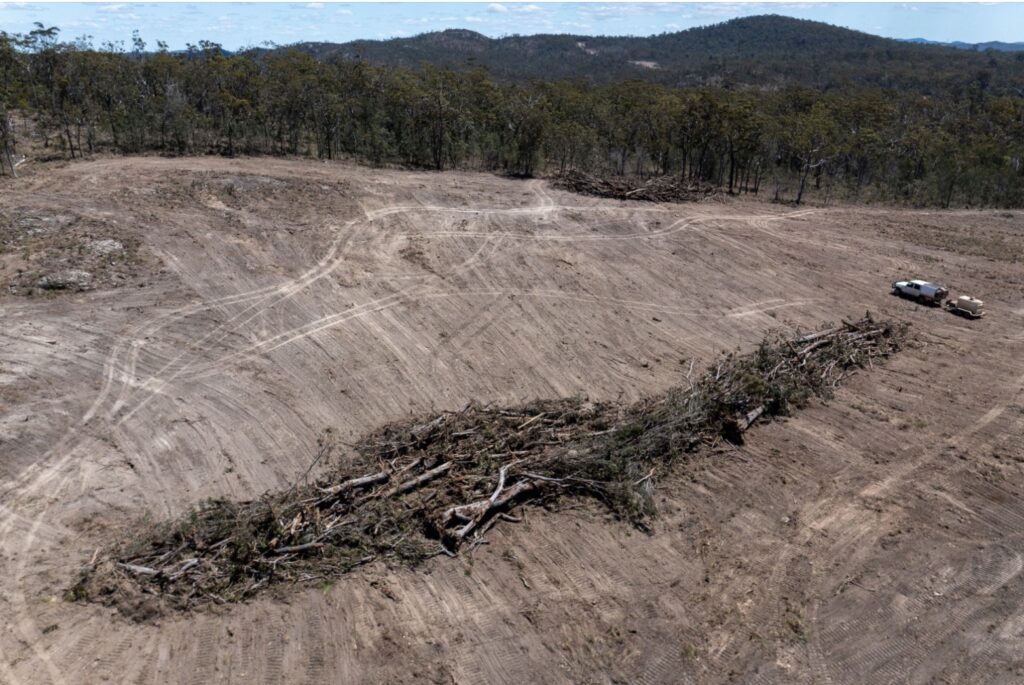
Just where are the priorities of the vocal environmental activists? Their silence to this mad destruction is deafening. Ignoring the physical environmental damage and biodiversity loss is easy if you live in the inner-city electorates that voted in the independent Teal candidates. But for those living in the affected areas, the scars are not only all too visible, but intrude negatively on the livelihoods of those directly affected.
There are plans to destroy 1,100 hectares of wet tropical forest in North Queensland to install the Chalumbin wind factory with a nameplate of a measly 600 MW.
Also, US conglomerate Apple pulled out of backing Andrew Forests’s Upper Burdekin project in Queensland after discovering the project would destroy 750 hectares of koala habitat and pose threats to other vulnerable species.
The CEO of the government’s Clean Energy Finance Corporation, Ian Learmonth, had to concede on ABC Radio National recently that the eastern Australian landscape will look radically different “if we’re going to get to 82% renewables by 2030…We’re going to need the right infrastructure to capture that energy, and therefore, there will be an impact”. He couldn’t or wouldn’t answer a question about who is having honest conversations with the public and the communities affected by the planned radically different landscape that will result from bringing in a massive renewable energy replacement system.
Bowen and his followers present the transition to renewables as a smooth road without any issues. However, they downplay the required intensification of mining for copper, nickel, cobalt and rare minerals, the massive clearing, and the eye-watering cost blowouts. Urban consumers follow this charade because many know little about the energy realities underpinning their existence. They believe digital gadgets and automation will somehow detach society from the physical world and allow us to do more with less.
It was announced recently there are plans to build the nation’s largest solar factory just a stone’s throw from the Great Barrier Reef. You can’t injure a frog to build a dam in this country, but you can flatten 2,700 hectares to stop “global boiling”.
In a future blog, I will cover the environmental carnage being wrought in more detail. It will be about the massive wind factories, pumped hydro schemes and transmission lines installed in forests along the spine of the Great Dividing Range in Queensland. All are exempt from the Vegetation Act 1999 laws that control land clearing in the state.
The Energy Superhighway
Bureaucrats have come up with a catchy slogan, “energy superhighway”, to describe the new 500 kilovolt (kV) transmission lines and interconnectors required to support the new, beaut “clean” energy system. However, before, during and after making announcements of a large-scale electricity grid extension, they forgot to talk to the directly affected landowners. Landholders and farmers are situated in the path of 76-metre steel towers – the same height as the towers on the Sydney Harbour Bridge – and carry cables on 70-metre-wide easements. They conjure images of voltage spiderwebs that will not only massively disrupt their farming practices and livelihoods but also scar the landscape and devalue their properties by at least 30 per cent. They are the casualties on the road to renewables.
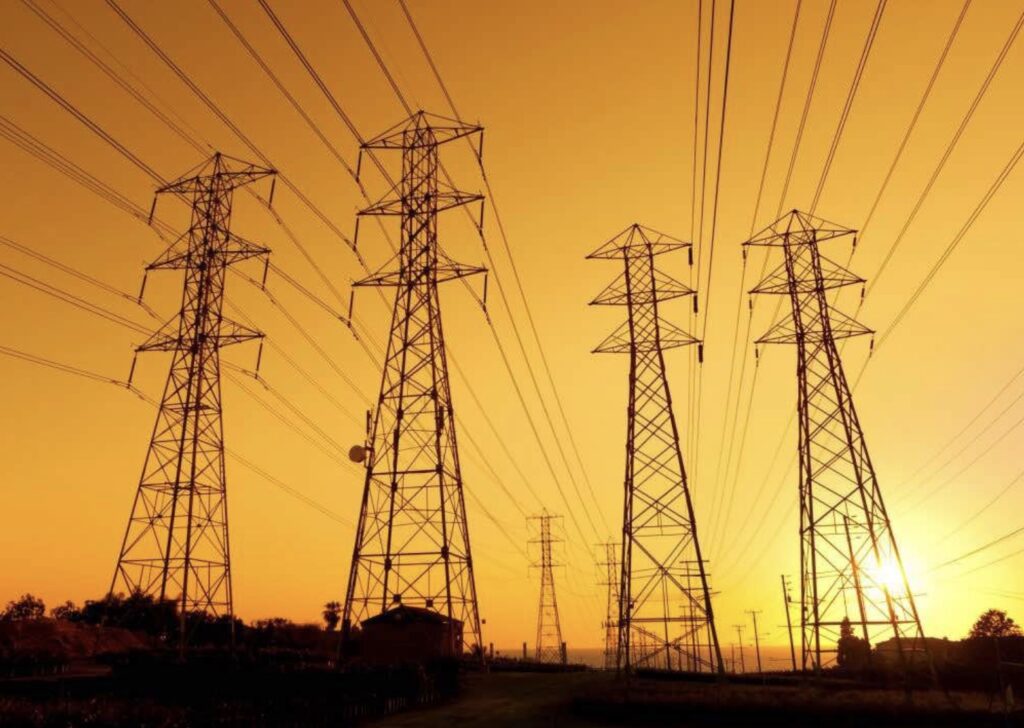
We are only now hearing of the intended impacts as energy providers are under immense pressure to build the transmission lines before more coal-fired power stations close. For instance, the proposed renewable energy zones require large areas of land to be cleared for new facilities and transmission lines, removing thousands of hectares of wildlife habitat in Tasmania, Victoria, New South Wales and Queensland. The renewable age will only serve to further fragment and lose habitat connectivity on a massive scale.
The rural communities across the eastern seaboard are bearing the brunt of this insidious and rapid change. However, they are fighting back. They don’t take too kindly to copping this burden so city-dwellers can assuage their guilt about continuing to live a comfortable lifestyle, as long as it is powered by renewable energy. City people are not affected by this rapid transformation. They won’t have a 500 kilowatt (kW) power line running through their property under the threat of compulsory acquisition or have to support 300 wind turbines or 10,000 hectares of a solar factory. Yet all this work is being carried out to maintain their extravagant lifestyles.
The rural landholders are being asked, or forced, to accept the changes. It is no surprise they object to being collateral damage to an ill-thought-out energy policy. We are on a rapid path of double transformation of our energy production and use – fully electrifying the economy – while switching to firmed renewables.
Landholders in the Kilkivan, Woolooga and Widgee areas of the Gympie hinterland in Queensland are affected by new transmission lines to supply electricity for a pumped hydro station connected with the doubling of the existing Borumba Dam at Imbil. Translink has played neighbours off against each other to achieve benefits for themselves, not the landowners. The other issue with this dam project is whether there will be enough water for existing farmers as their allocations are reviewed and revised. Farmers producing macadamias, avocados and other crops are told their water allocations will be reduced to one day a week. It will put most of them out of business.
In the Snowy Valley, workers from Transgrid are being turned away from hotels and petrol stations as local communities band together to fight the massive intrusion into their lives, where they are expected to host the infrastructure for renewable energy transmission.
A close analysis of the public reports is not a good read. The federal government is spending an obscene amount to “rewire the nation” when we already have an adequate transmission line system.
Australia has not seen the erection of major transmission lines over such an extensive area for more than 50 years. The simple reason why there is a need to duplicate the transmission line system is because of the isolated and random location of the renewable factories and to feed back energy into the grid generated from solar panels on houses.
In this mad rush, overseas energy companies build these renewable monstrosities in far-flung places without any coordination whatsoever. To highlight this incompetence and farce, 75 per cent of the wind and solar factories built in Victoria so far, which are operational, are sending electricity into the ground because they are not connected to the grid.
There is a real sense of panic trying to meet the government’s impossible targets and ensure we have some form of electricity once the more coal-powered stations close. The former chief executive of the Australian Energy Council, Matthew Warren, said Australia can only build 500-600 kilometres of transmission lines annually, and it is unrealistic to speed this up. This means it will be 2040 before all the renewable sites will be connected to the grid. So, who decided we can achieve the targets by 2030? Were any engineers involved in the process? It just doesn’t add up.
In Australia, the increasingly remote locations chosen for wind and solar generators require serious upgrades to transmission infrastructure, adding hundreds of millions to transmission costs that would have otherwise been avoided had we simply stuck with conventional generators and not squandered $60 billion in subsidies to intermittent wind and solar. As any first-year physics student will tell you, transmitting electricity over distances results in a mathematically predictable loss of the power transmitted over any given distance. The greater the distance, the greater the absolute loss.
Examples of monumental promises and failures
In 2018, Prime Minister Malcolm Turnbull pitched his mega-pumped hydro project to the Australian public. It was touted as a solution for wind and solar power’s hopeless intermittency issues, and he called it Snowy 2.0, and it would cost $2 billion.
However, the Snowy 2.0 scheme will be the country’s most monumental engineering failure. It is a travesty that it shares its name with Australia’s most incredible engineering achievement. The real Snowy Hydro-electric scheme works efficiently and profitably, supplying electricity and water. It catches and stores water, uses it to generate reliable electricity and controls and releases water for irrigation.
Snowy 2.0, on the other hand, will be a giant, expensive, inefficient battery that will consume water and electricity to produce very little electricity, in contrast to the original Snowy Mountains Hydro Scheme’s excellent reputation and engineering excellence. We were told that this pumped hydro storage scheme is a winner because water is pumped uphill when energy is cheap (generally at night) and flows downhill through turbines during peak demand, creating a low-tech but powerful “water” battery.
However, it will consume 1.5 kW per hour to pump water uphill for each 1 kW per hour of electricity it will deliver due to losses in the pumping and generation cycle and transmission. Massive construction sites and roads across 35 kilometres of Kosciuszko National Park have destroyed thousands of hectares of alpine habitat. Twenty million tons of excavated spoil will be dumped in the park. Four 330 kV transmission lines on two sets of 76-metre towers over a cleared easement swathe of up to 140 metres wide will traverse over eight kilometres of the national park – the first time transmission lines have been erected in a New South Wales national park for over 50 years.
The New South Wales government sneakily amended the park’s management plan to allow this. They altered a provision in the plan that requires “all additional telecommunication and transmission lines to be located underground” by inserting “except those constructed as part of the Snowy 2.0 Project” without any community consultation.
It is no secret in engineering circles that the Snowy 2.0 tunnels are far too long for an efficient pumped hydro system. Leading geologists and engineers know that the geological conditions for tunnelling in a typical tectonically induced alpine geology with opposing faults, tight folds, shears, bedding plane shears, and abutting perched waters are challenging and expensive. They knew this from geotechnical reports from the original Snowy scheme. And they were right, as the project costs have blown out way behind original estimates. It is simply remarkable that this project went ahead at all. It was doomed because of geology alone, let alone the defective concept.
One of the tunnel boring machines critical to the project had barely struck a blow before grinding to a halt, only 150 metres from the entrance to a proposed 17-kilometre tunnel, after the tunnel roof collapsed in and around the machine. The public was told the debacle was an “unscheduled pause”. Since its commissioning in March 2022, this machine has been idle and stuck underground most of the time.
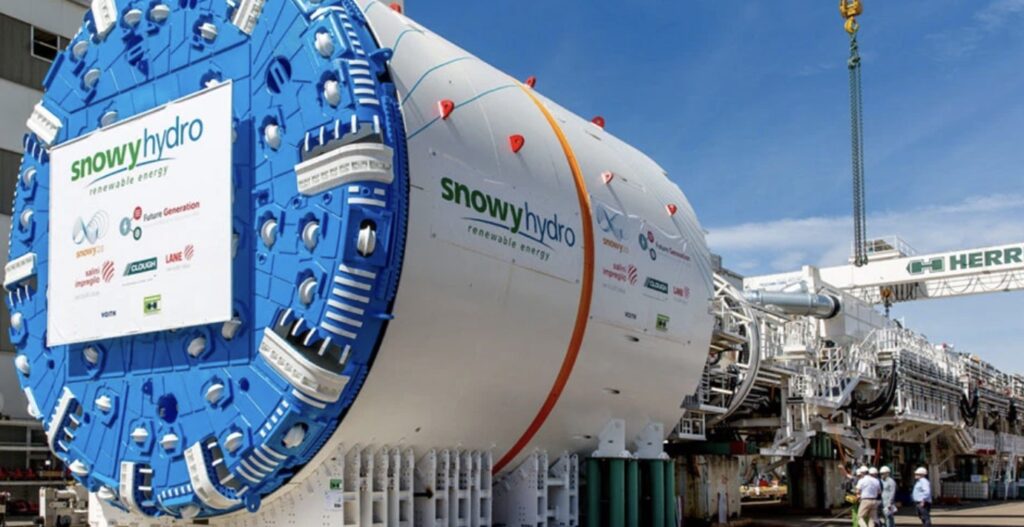
In January this year, the project made headlines again after it was announced there would be a one-year delay. Then, in May, another announcement pushed the estimated completion out another two years. In five months, the official completion date has been delayed by three years, from 2026 to 2029. When first announced by Turnbull, Snowy 2.0 was going to be built by 2022. The construction cost estimate has blown out ten-fold to $20 billion, plus $10 billion for the plant and another $9 billion for 1,000 kilometres of 500kV transmission line connections to Sydney and Melbourne.
Snowy 2.0 will not be a renewable generator or provide baseload power. It is equivalent to a very inefficient battery and thus will be a net load on the NEM.
At some point soon, the reality will bite as the realisation that this project is ridiculously unviable. As the major funders, the public is being lumbered with the risks and costs of a massive white elephant. Bowen needs to stop muttering his “deep concern” with each new delay and cost blowout and admit enough is enough before the environment is further trashed and billions more taxpayer money is wasted.
Because of the foresight of politicians and engineers over 70 years ago, Tasmania has built up an enviable position of generating a majority hydroelectric-powered grid. Unsurprisingly, Tasmania has been targeted as part of the grid expansions identified as essential by the AEMO in its national Integrated System Plan, the 30-year blueprint that maps out an initial 80 per cent of renewables by 2030.
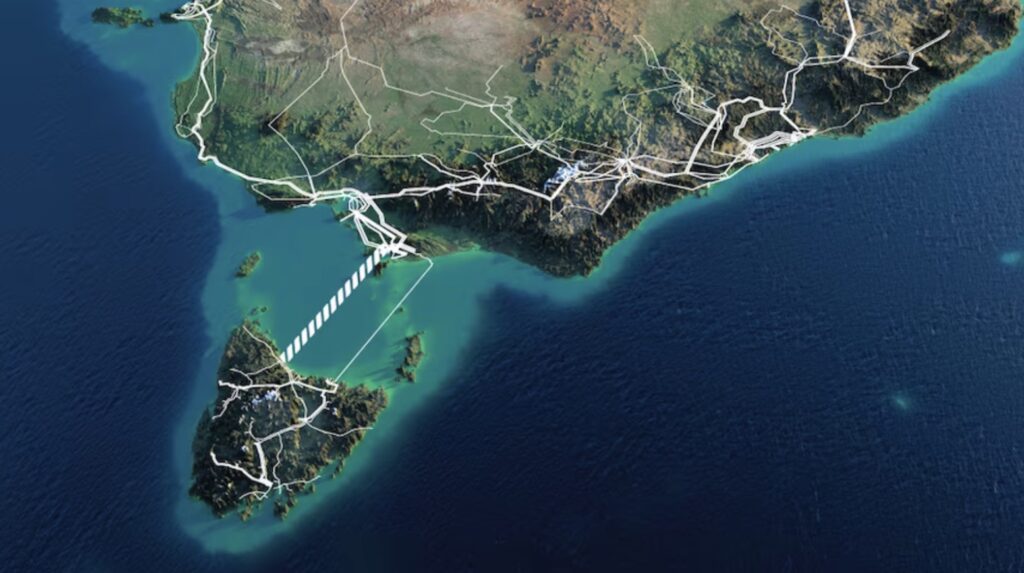
Tasmania has an enviable hydropower generation capacity (2,270MW) and four clusters of wind turbines with a total notional capacity of 556MW. Or at least it did until fairly recently.
Its hydropower is available on demand (except for lengthy dry conditions when it has to turn to diesel generators). However, wind only delivers occasional power around 30 per cent of the time, and operators don’t know which 30 per cent of the time that might be with any meaningful advance notice.
Project Marinus has designs to install two undersea 750 MW high voltage direct current cables across the Bass Strait between Tasmania and Victoria, sending renewable energy directly into the national market. It is a project Victoria desperately needs as it is short of renewable electricity.
The idea is a joint venture between the Tasmanian, Victorian and federal governments. It would export power from Tasmania’s hydro schemes, as well as from planned wind farms and pumped hydro. The project includes significant upgrades to the Tasmanian transmission network to accommodate the new link. The Australian Energy Regulator has assessed the project and predictably asserts that the net consumer benefits far outweigh the costs. However, for Tasmanians, it is a terrible project, plunging the state into further debt for no benefit.
Tasmania is already connected to the mainland’s power grid via a high-capacity undersea cable acting as an interconnector between both state’s remaining coal-fired power plants.
However, it turns out Tasmania no longer has an abundant electricity supply. We now find out Tasmania only functions as it does because of the reliable energy from Victorian brown coal.
Tasmania often struggles to supply enough energy for its industries, let alone exporting it interstate. Major factories are being told no further power is available for upgrades and expansions, and Tasmanian consumers are paying more for their electricity.
The rent seekers are busy spruiking the Marinus Project as “the battery of the nation” once another cable with a multi-billion dollar price tag is built to seamlessly allow the flow of Tasmania’s wind and hydro onto the mainland. But the power cord has blown out!
When it was first announced, the original cost estimate for Marinus was between $3.1 and $3.8 billion of taxpayer funds, with 80 per cent financed through a cheap loan scheme. However, the Tasmanian Premier has put doubts on the project by admitting last August “a material and a significant increase [in costs] for Marinus Link”, a cost that Tasmanians cannot afford.
The costing debacle is a disturbing trend with all the other major renewable projects nationwide. Prime Minister Albanese guaranteed that Tasmanian power prices would be lower with Marinus. At the time, Tasmanians were told that lower energy prices would offset increased network charges of $40 a year per customer by $100. The Tasmanian government has now realised that promise was fanciful as the project’s actual cost becomes apparent. The Tasmanian Premier has asked Albanese to stump up more money if the Marinus Link proceeds because the Tasmanian share of the expenses is way beyond its debt-financing capability.
But what is worse is we have seen Tasmania squander its natural advantage of abundant zero-emissions hydroelectricity in a quest to profit from opening its supplies to back up intermittent solar and wind generation on the mainland. However, Tasmania is running fossil fuel generators to back up its supplies rather than save the nation. The promised “battery of the nation” has gone flat!
What is conveniently overlooked is that while the government claims wind power is cheap, we now realise it is only so when taxpayers have to stump up billions to pay for a cable. If Tasmania built an additional power plant, such as nuclear, it wouldn’t need the interconnector at all. The undersea cable is just another hidden cost of the renewable transition.
The reality is starting to bite
AEMO struggles to admit the obvious – the targets laid out in their ISP cannot be met unless Australians are prepared to live in a country where the electricity supply cannot be assured.
The proposition that we could replace our baseload energy supply from coal with intermittent renewable energy has been exposed as delusionary. For example, if South Australia’s 16 wind factories were running at full capacity, they would generate 2.1 GW, far more power than the state consumes in the middle of the day. But at lunchtime on Friday, 1 September this year, they were producing just 29 MW, less than two per cent of their nameplate capacity. A quarter of the state’s power came from Victoria, where the brown coal power stations ran at full tilt. Another quarter was generated from gas.
South Australia has the highest concentration of renewable energy of any state in Australia. Yet, it cannot generate enough power on a windless day or any night to satisfy its modest demand. It also has the most expensive retail electrical prices in the country.
AEMO likes to use the term “unserved energy”, or USE, to explain energy that cannot be supplied to consumers when demand exceeds supply.
AEMO admits that USE can cause “involuntary load shedding,” another long-winded way of saying blackouts.
And AEMO expects us to believe that none of this could have been foreseen 14 months ago. What sort of fools do they think we are?
We were assured that the now-discredited 2022 ISP was developed with the help of 1,500 stakeholders at 31 forums and webinars backed by 198 written submissions. It was written based on “continuous dialogue on every aspect” and “exhaustive consultation”, yarda yarda.
But no one seems to have asked the obvious questions – could it keep the lights on? How can a plan be low-cost when it involves a six-fold increase in current electricity output?
The only way this stupid rapid transition to 82 per cent Net Zero will pass the giggle test is if there is immediate action to facilitate the deployment of nuclear power.
Summing up
The benefits of building renewable factories with existing grid infrastructure have been ignored. The plans to pollute the landscape with additional massive transmission lines, at significant cost, to follow and catch up with new renewable projects is ludicrous. For some reason, adopting small-scale nuclear reactors at brown-field sites is not even considered a viable alternative to this weather-dependent renewable energy debacle that wastes public funds on a monumental scale.
For example, Tasmania only has a population of around half a million. Instead of trashing native forests in western Tasmania for new transmission lines and wind factories and spending billions on undersea cables, they should build a small nuclear reactor in conjunction with their existing hydro schemes to fix their current energy supply problems and maintain their status as a low CO2 emission state. Nearby South Australia has massive uranium reserves that could supply Tasmania’s nuclear fuel requirements easily and cheaply.
Part of the problem is that the elite have blinkered faith in climate alarmism, and nary is there any room for another point of view or a dose of reality. While we have a political establishment in decline that is utterly fixated on wind and solar renewables:
“…they will continue to inflict their ignorant energy fantasies on ordinary people and make excuses for their failures”.
Professor Andrew Blakers, director of the Centre for Sustainable Energy Systems at the Australian National University, is a typical example of a renewable energy zealot who does not know what is occurring outside his cosy city office in Canberra. He argues the opposition to the Net Zero scheme is unjustified because:
We have an emergency. We need to decrease the amount of CO2 going into the atmosphere as quickly as we can. That is far more damaging to regional areas through drought, bushfires and floods than the odd transmission line here and there”.
I would love to see Professor Blakers argue that point in person to the rural communities affected by the proposed 28,000 kilometres of monster transmission lines from Cairns to Adelaide under the threat of compulsory acquisition.
What we are seeing in Australia is mirrored overseas. Governments worldwide have pledged to reduce emissions to Net Zero by 2050. However, almost all of them are not on track to meet targets by 2030, let alone 2050. It is not surprising as a report has indicated that an annual global investment of $2.7 trillion is required to achieve Net Zero by 2050.
In Germany, wind turbine sales have fallen 80 per cent as local communities have reacted fiercely to their natural environment being turned into an industrial landscape. Additionally, Germany and most of Europe have just completed a 36-day period when electric generation from wind averaged 10-20 per cent of normal, something the renewable industry and mainstream media are silent about.
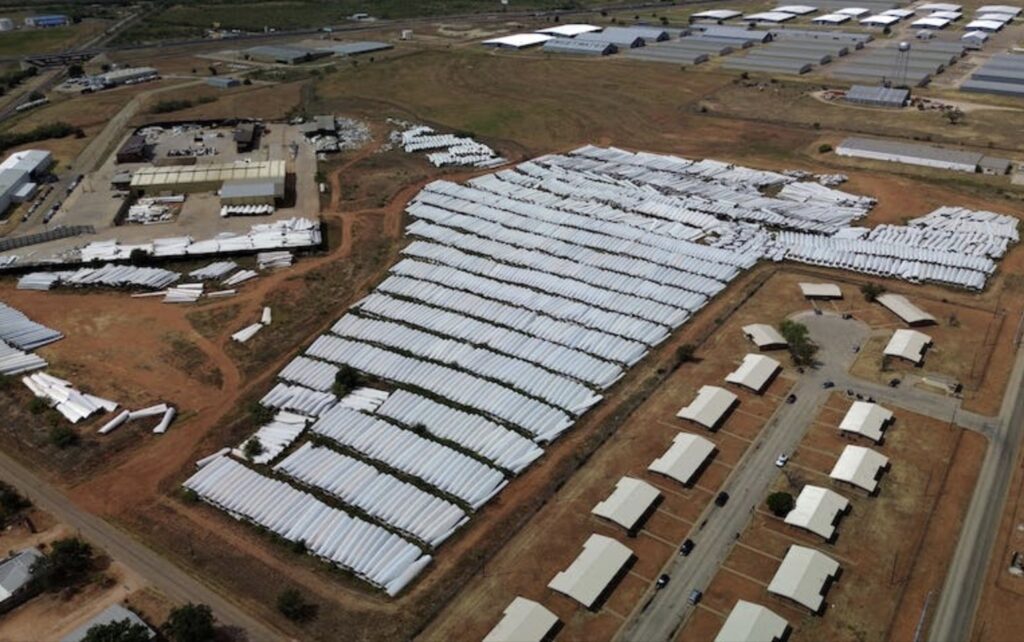
Greece is at a similar stage to Australia. They plan to install about 20,000 wind turbines in the proudest mountain ranges over the next few years. The same mountains that have stood since the beginning of time as eternal pedestals, unchanged, unshakable, that will now become an industrial zone for centuries to come.
Wind Turbine and solar panel-generated power is the wrong technology for the 21st century for all the reasons we already know about – they are dispersed, intermittent, unreliable, have a short service life, are materially intensive, have low output, and are damaging to the environment and our health. They simply cannot be relied upon for a modern economy.
It is undeniable that current Net Zero plans are astronomically costly, technologically impossible and politically unstable.
The Net Zero mantra is an energy policy that “rejects the good in favour of the unworkable”. Labor’s false market is protected from competing technologies like nuclear and is in crisis. It is not designed to achieve Net Zero. Its legacy will ensure Australians pay more and more for unreliable energy for decades and that other avenues like nuclear will be stifled through a lack of political will.
Implementing an overly ambitious emissions reduction scheme will only lead to further price increases and less reliability, while our only baseload energy sources are suppressed.
Continued price controls and other regulatory interventions by the government will see the further decline of energy-intensive manufacturing and a slippery journey into a moribund world of lower living standards and productivity losses.
We risk seeing the contemporary green economy reverting to old-fashioned protectionism and increased state power. Pumping trillions of dollars to accelerate the energy transition magnifies the illusion of promised economic benefits.
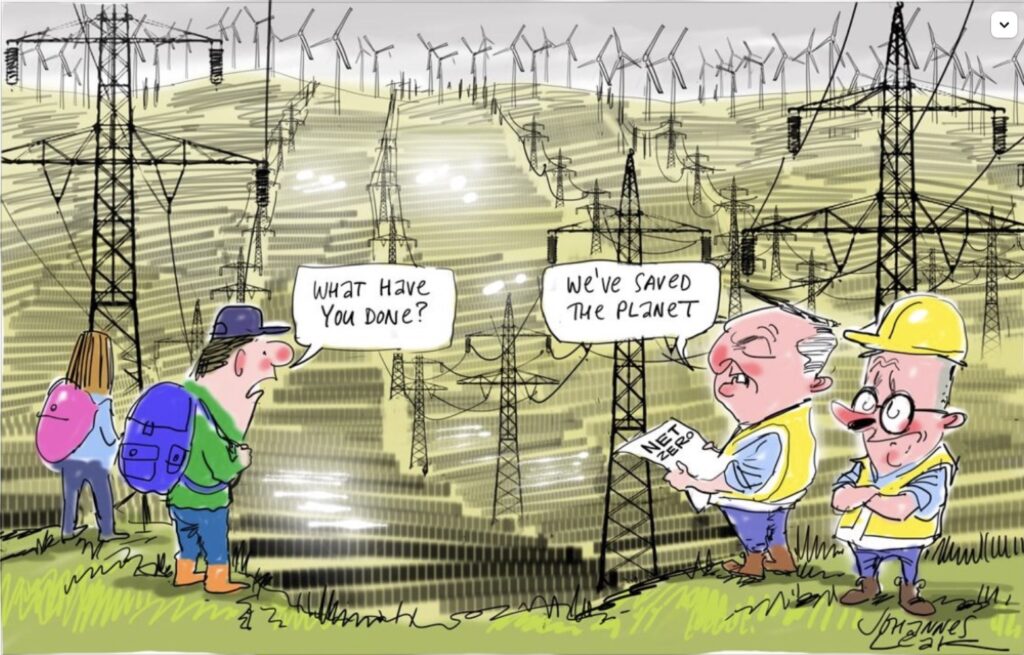
A great source of reference. Thank you Robert.
An excellent expo Robert of the wind turbine and solar panel-generated power scam technology.
The only near future is fission and then fusion; until then we keep reliable gas and coal.
I’m sorry to say this but I feel you’ve really lost the plot on this one! Buying into these conspiracy theories around climate and energy, and propagating them, tarnishes your own reputation and does a great disservice to your loyal readership.
I am sure that the transition to renewables here and abroad will be painful at times, and those who are suffering from sometimes poor decision making do need a voice – as much as the collateral damage to the natural environment needs to be called out.
But the transition is necessary, since the climate crisis is both real and increasingly apparent all around us. It is an existential threat not just to humans, but to much of the natural world as we know it, too – and, of course, to forestry, which is your ‘foundation’ topic that I feel you would be wise to return to in future blogs.
I’ve been gazing out my window for at least the last 10 years, waiting with rapture, as I have been told the end of the world is looming, and it is just over the horizon. I was losing faith. Thank you for your reminder. I will go down to the sea again, and dip my toe carefully into it’s boiling waters. Thank you for saving me, now I can be a weather denier again.
Thanks Robert.
I am very glad I live in WA and that we are not part of the integrated energy grid. WA also has a gas reservation policy for use locally. Australia has a great natural advantage in energy resources (coal, gas and uranium) that politicians and “environmentalists” are busily attempting to shut-down. Net Zero in Australia, if it is ever achieved, will do nothing to alleviate the so-called “climate crisis”. Back to the cave…….
Our lifestyle is sacrosanct to society. Look at the political use of ‘Labor want to ban utes’ by Morrison. Nobody wants to give up our energy hungry lifestyle despite its costs and there is a blind focus on a strategy of replacing the source of energy, rather than the hard political yards of reducing consumption and potentially our wealth. I haven’t heard any discussion about population. Surely one of the biggest drivers of Australia’s emissions is population growth? The debate is narrowed and not all options are on the table.
The point you make regarding the energy transition isn’t an option that needs to be stressed. We have passed peak oil and this resource is disappearing so a transition to other energy sources is essential in any case.
Just shows how delusional Casanova Bowen really is! Just struts around spreading Bull to the masses.
to the masses.